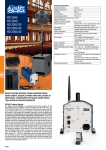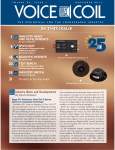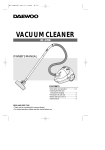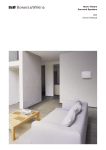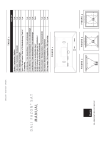Download Owners Manual REV10005.indd
Transcript
0XOFS«T.BOVBM Congratulations on choosing Krix Krix loudspeakers are designed to reproduce the highest quality sound. To ensure the best performance from your speakers please read this owners manual carefully. Please contact your friendly Krix retailer or Krix directly with any further queries. before you begin ! Loudspeakers contain permanent magnets and the magnetic field extends beyond the speaker cabinet. As a guide, magnetically sensitive equipment (such as old CRT televisions or credit cards) should be positioned at least 300mm away from the speakers to avoid magnetic interference. amplifier power Loudspeakers have a recommended power rating. This rating is given as a guide to match the appropriate amplifier to your speakers. Your amplifier is likely to reach maximum power output before the maximum volume setting is achieved. Source material volume levels can vary, however as a guide, we suggest that you do not exceed zero on the digital display or 12 o’clock on conventional volume dials. Turning the volume dial past the amplifier’s maximum output power will create clipping (distortion). ! Driving your amplifier into clipping is likely to damage your speakers. Clipping can be recognised as harsh, aggressive distortion. floor spikes The Krix models: Harmonix and Neuphonix are supplied with spikes sets. The use of these spikes is optional. The spikes may be used to help create a solid foundation for the speaker, particularly on carpeted floors. To protect uncarpeted floors place the supplied metal disks under each spike. The height of each spike is adjustable and allows the speaker to be levelled on uneven floor surfaces. Install the spikes by screwing them into the threaded inserts on the base of the speaker and secure by tightening the lock nuts. in cabinet use Krix speakers can be used in TV cabinets, bookcases and custom joinery, however care must be taken to avoid creating acoustic problems. • • Avoid placing your speakers deep within cabinetry as this can create acoustic reflections and echoes detrimental to sound quality (figure 1a). Flush mounting is best (figure 1b). Rear vented models: Atomix, Equinox, Rhythmix and Neuphonix require care to avoid restricting bass output from the vent. (figure 2a, 2b) Front vented Krix models are ideally suited for use in cabinets. (figure 2c) It is possible to damage a 200 Watt speaker with a 50 Watt per channel amplifier, as clipping occurs at a lower volume level with a lower powered amplifier. • rated impedance The nominal impedance of Krix loudspeakers are conservatively rated to present a comfortable load to quality electronics. The nominal rated impedance of your speaker affects how much electrical current the speaker will draw from your amplifier. A 4Ω (ohm) speaker will draw more current from an amplifier than a 6Ω or 8Ω ohm speaker. grille Krix speakers are supplied with acoustically transparent cloth grilles. These grilles may be removed if desired. To remove the grille firmly grip the edges and gently pull away to reveal the front baffle and drivers. To reinstall the grille, line up the grille clips with small holes in the front baffle and gently push until locked in place. cabling Connecting your speakers with adequately sized speaker cable will ensure optimum performance. As a guide, use at least 16AWG cabling for runs up to 8m, for longer runs consider using thicker 14 or 12 AWG cable. connecting your speakers Note: Krix models: Phoenix, Harmonix and Neuphonix have 2 pairs of terminals for the high-frequency (HF) and low-frequency (LF) inputs. These inputs must remain linked for conventional use (figure 4). When Bi-wiring, these links should be removed and each pair of terminals connected independently (figure 5). Bi-amping is also possible, where an independent amplifier is used for the low frequency and high frequency sections of the speaker. Please ask your Krix dealer for specific recommendations. speaker positioning - 2 channel, stereo When positioning your speakers try to find the best compromise between the suggestions below to suit your listening preferences and room. a. The widest stereo separation is achieved when the left and right speakers form an equilateral triangle with the primary listening position. In this setup small movements from the primary listening position can create large shifts in the central stereo ‘image’. (figure 6a) b. If the speaker spacing in reduced to 2/3 the distance from the primary listening position the central stereo ‘image’ will become more homogeneous but also more monophonic. This setup will create a larger ‘sweetspot’ that can be enjoyed by more listeners. (figure 6b) c. A good balance between the above suggestions can often be found with an ‘equal legged T’ arrangement. (figure 6c) Angling your speakers inwards towards the listener can also help to focus the centre stereo ‘image’ of your speakers. speaker positioning - home theatre tone controls Krix speakers have been designed to create an accurate, balanced sound without tone control adjustment. However, for reasons of personal taste or room acoustics, some adjustments may be desirable. Be aware that excessively boosting the bass can overload the low frequency drive units, particularly at high volume levels. To ensure optimum speaker performance it is important that your system is connected properly. 1. Turn off all electronic equipment. 2. Follow the connection instructions supplied with your amplifier or receiver. 3. Prepare speaker cables for connecting to speakers by neatly stripping cable ends. Care should be taken to eliminate loose strands of wire that may be present a short circuit hazard. Alternately you can use spade lugs or banana plugs (figure 3) 4. Take care to assign the same cable colour or trace from the positive (+) connector on the amplifier to the positive (+) connector on the speaker. (figure 4) 2 left and right speakers The desired spacing of your left and right speakers for home theatre applications may be a slightly closer together than for two channel stereo. A good configuration to try first is ‘equal legged T’ arrangement (figure 6c). The goal is to create a smooth, consistent soundstage across the front of your room that complements the action on the screen. centre channel speaker Position the centre channel speaker above or below your screen. To help anchor the dialogue to the screen, keep the centre speaker as close to the screen as possible, at approximately seated ear level. Angling your centre speaker up or down towards the listening position can improve dialogue intelligibility. rear speakers Rear speakers should be placed to each side and/or behind the listening position. Exact positioning will be dependent on your room layout and the number of surround/rear speakers in your system (e.g 5.1, 6.1, 7.1 and beyond). Refer to your receiver/amplifier manual or ask your Krix dealer for more recommendations. banana plug binding post subwoofer If a subwoofer is to be used, please refer to your subwoofer manual for suggested subwoofer placement. spade lug speaker fine tuning wire Obtaining the best sound from your speakers may require some experimentation. Try to find a balance that suits your listening preferences and room from the suggestions listed below: • • • Moving speakers closer to a wall or corner will increase bass output but decrease aural ‘clarity’ and ‘depth’. (As a guide try position your speakers at least 50cm away from a corner and 20cm from a rear wall) Try to keep the acoustic environment (bookcases, walls, curtains etc) surrounding your left and right speakers similar to help create a balanced soundstage. In rooms with few soft furnishing your speaker can sound bright and lack ‘detail’. Therefore adding curtains, carpets, picture frames, couches and bookcases etc can help absorb reflected sound and improve sound quality. Also rooms with bare parallel walls can suffer from ‘slap echoes’ as sound bounces or ‘flutters’ between the walls. Improvements can be made by adding soft furnishings on or between these walls. caring for your speakers figure 1 left speaker figure 3 left speaker HF HF LF LF to right speaker to right speaker amplifier L amplifier R L outputs R outputs figure 4 figure 5 2 3 equal To clean your speaker cabinet gently wipe with a damp cloth. Do not rub hard on the cabinet at any one point or you may leave a polished spot. To clean the grille, remove from the speaker cabinet, as previously described, and vacuum at a low power setting using a soft brush attachment. The bass driver(s) and tweeter can be gently dusted by using a soft bristled brush. ! figure 2 1 Wherever possible, do not touch the speaker diaphragms, particularly the tweeter diaphragms, as they are fragile and easily damaged. equal 1 figure 6 Thankyou for choosing Krix 3 ,SJY-PVETQFBLFST1UZ-UE $IBQNBO3PBE )BDLIBN4" "VTUSBMJB 5 ' MJTUFO!LSJYDPN 3FW





